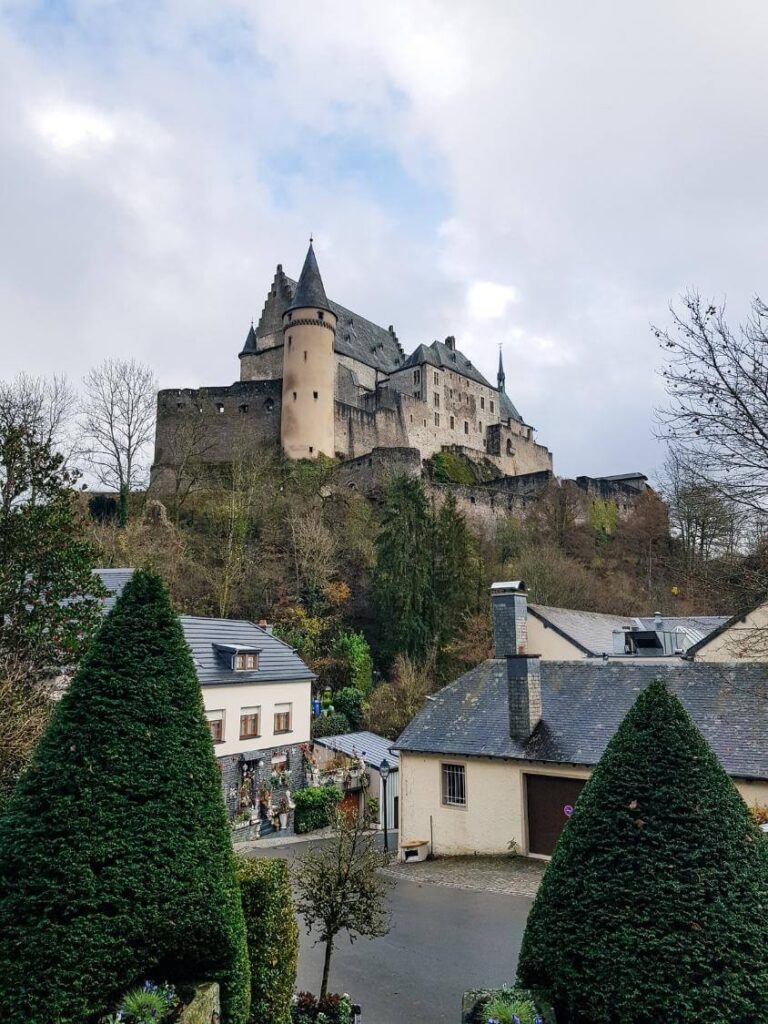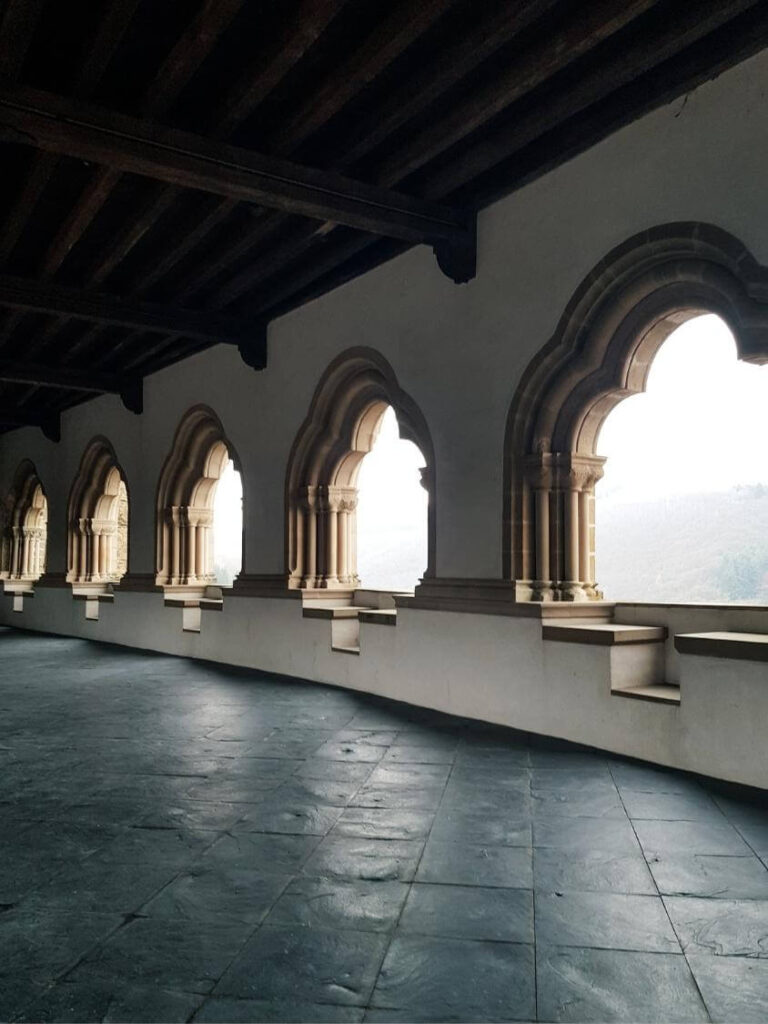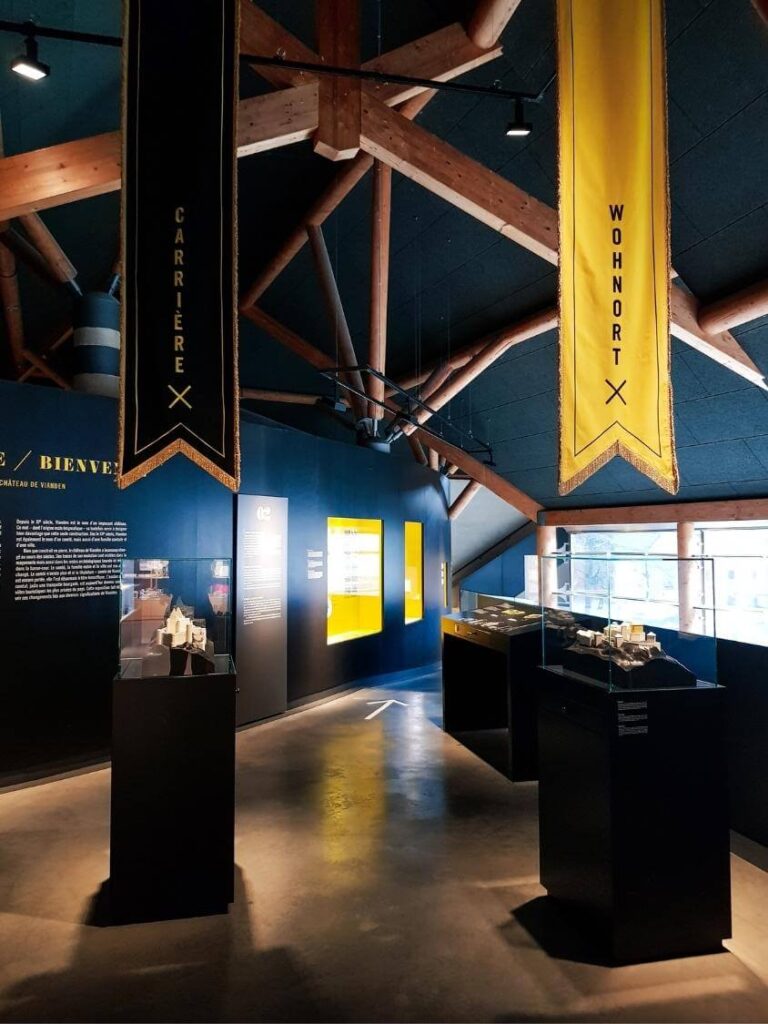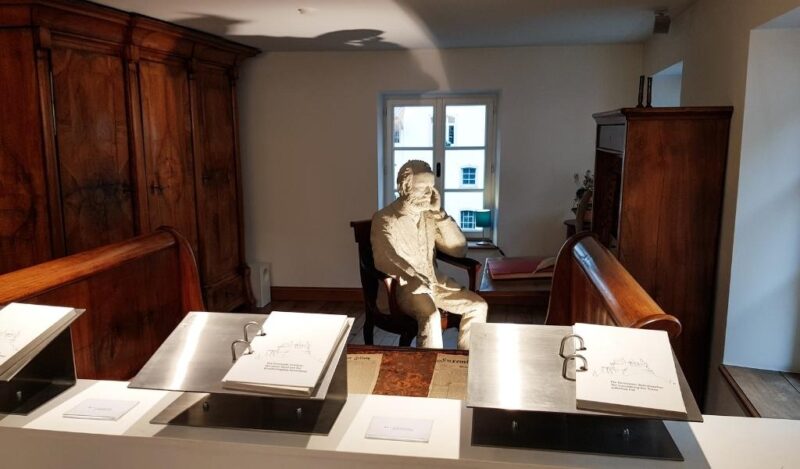The Vianden Castle (in Luxembourgish, Veianen Schlass; in French, Château de Vianden; and in German, Schloss Vianden) is one of the most beautiful feudal residences in Europe and it’s easy to see why. Located in a town and commune of the same name in northern Luxembourg, this medieval fortress is a true masterpiece of Romanesque and Gothic architecture!
The Vianden Castle was built between the 11th and 14th centuries to house the powerful Counts of Vianden. But after centuries of dominance and influence in the region, their descendants decided to move to the Netherlands and the monument was left abandoned, as well as at the mercy of looting and natural disasters.
All this, combined with an endless succession of owners, meant that the Vianden Castle remained in ruins until the second half of the 20th century. Fortunately, Grand Duke Jean donated the former feudal residence to the Luxembourg State in 1977, which restored and returned it to its former glory!
So, do you want to know more about the Vianden Castle: Best Tips For Visiting In 2024? Keep reading!
This post may contain affiliate links, meaning I earn a small commission if you make a purchase, at no additional cost to you. Please read my disclosure & privacy policy for more information.
No time to read now? Pin it for later!


- Brief History of the Vianden Castle
- How to Get to Vianden Castle
- What to See at Vianden Castle
- Octagonal Tower
- Arms Hall
- Knights' Study
- Lower Chapel
- Ancient Kitchen
- Archaeological Crypt
- Inner Courtyard
- Chemin de Ronde
- Upper Chapel
- Byzantine Gallery (or Byzantine Hall)
- Jemmy Koltz Room
- Charles Arendt Room
- Banquet Room
- Bedroom
- Counts' Hall (or Vic Abens Room)
- Nassau Tower (or Genealogy Room)
- Grand Kitchen
- Dining Room
- Well
- Knights' Hall
- Black Tower
- Information Center
- More Posts about Luxembourg
- More Posts about Castles and Palaces
- What Photography Gear Do I Use?
Brief History of the Vianden Castle
Did you know that the Vianden Castle is situated on a promontory at over 300 meters above sea level? And that the human occupation of this rocky place dates back to the Roman Empire? Yes, archaeological excavations at the foundations of the monument found traces of a late-Roman castellum (4th-5th centuries) and a Carolingian refuge (9th century)!
After successive alterations until the 10th century, the military fort gained another building and a chapel around the year 1000, as well as a keep a century later. This last intervention coincides with the arrival of the Counts of Vianden (the ancestors of the Royal Families of Luxembourg and the Netherlands), who established their residence here.


In the following centuries, the various counts who inhabited the Vianden Castle continued to expand and modify its architectural plan, in addition to reinforcing its defensive structure. But in 1820, William I (the Grand Duke of Luxembourg and King of the Netherlands) sold the medieval fortress to a local, who began deconstructing it to profit from its materials!
Although the medieval ruins were much appreciated in the 19th century, especially by Romantic artists (the writer Victor Hugo himself lived in Vianden during his political exile), the disrepair of the Vianden Castle began to worry both the population of the town and the monarchs of the country. Therefore, the Grand Ducal Family of Luxembourg recovered the building and began a long restoration campaign.
How to Get to Vianden Castle
Most tourists visit the Vianden Castle (and the town itself) on a day trip from the capital of Luxembourg and that’s exactly what I did. Well, to get to Vianden, you must first take a train from Gare de Luxembourg to Gare de Troisvierges.
However, you’ll get off at Gare de Ettelbruck and take bus 570 towards Obereisenbach, Bei der Baach. Once again, you don’t get to do the whole route, as you’ll get off at Gare de Vianden. This trip from Luxembourg to Vianden takes about 1 hour, including changing from the train to the bus in Ettelbruck.


After arriving at Gare de Vianden, there are three ways to go up to the castle: on foot, by bus, or by chairlift. Unfortunately, I visited Vianden Castle during the low season when the chairlift was closed and there was no bus service. And although the ascent on foot is challenging, the views are well worth it!
Opening Hours & Ticket Prices
The Vianden Castle is open every day, except on the 1st of January and the 25th of December. However, the opening hours are different depending on the time of year: from 10 am to 4 pm (from November to February), from 10 am to 5 pm (in March and October), or from 10 am to 6 pm (from April to September).
As for tickets, they cost €10 (adults), 5€ (students), or €2.5 (children from 6 to 12 years old), and LuxembourgCard holders don’t pay admission. There are also special rates for groups and guided tours, which you can check at the physical ticket office of the Vianden Castle.
TIP: To discover and better understand the history of the Vianden Castle, as well as the functions of its rooms, I recommend that you buy the official audio guide. Its costs only €2 and is available in 10 languages (English, French, Portuguese, Italian, Russian, Mandarin, Spanish, Japanese, German, and Luxembourgish)!
What to See at Vianden Castle
Currently, the itinerary to visit the interior of the Vianden Castle is one-way, winding through several halls, rooms, and chambers over three floors. Each point of interest is referenced with a number, which coincides with the numerical reference in the audio guide and on the map. Still, the visiting circuit is a bit confusing and the order of some rooms seems to be reversed. Anyway, these were the spaces I visited:
GROUND FLOOR
- Arms Hall
- Knights’ Study
- Lower Chapel
- Ancient Kitchen
- Archaeological Crypt
- Grand Kitchen
- Dining Room
- Well
- Knights’ Hall
1st FLOOR (or NOBLE FLOOR)
- Inner Courtyard
- Chemin de Ronde
- Upper Chapel
- Byzantine Gallery (or Byzantine Hall)
- Banquet Room
- Bedroom
- Counts’ Hall (or Vic Abens Room)
- Nassau Tower (or Genealogy Room)
2nd FLOOR (or SUPERIOR FLOOR)
- Jemmy Koltz Room
- Charles Arendt Room
Octagonal Tower
The Octagonal Tower of the Vianden Castle is an imposing stone structure, which you can see as soon as you step out of the ticket office. And despite the visit to its interior taking place at a later stage of the itinerary, the official audio guide considers it the first point of interest.

Built from the ruins of the late Roman castellum, this Octagonal Tower was designed to accommodate one of the most fascinating spaces in the Luxembourgish monument: the Upper Chapel!
In the first centuries in which the Counts of Vianden inhabited the castle, the political, economic, and social system of Feudalism prevailed in Europe. And of course, the counts themselves quickly became the feudal lords of this region, controlling the entire territory and population.
Arms Hall
The Arms Hall is, at the same time, the first and last place you’ll visit inside the Vianden Castle. Located on the lower floor of the “Petit Palais”, between the Knights’ Study and the Knights’ Hall, it was a kind of “entrance hall”, serving as an antechamber to this second hall.

Another curious detail about the Arms Hall is its different construction phases. For example, the west wall is one of the oldest, dating back to the 10th-11th centuries. The vaults and windows are from the 13th-14th centuries, more precisely from the Gothic period. And other architectural elements were added in between, during the 12th century.
Knights’ Study
The next room is the Knights’ Study. Much smaller in size than the Arms Hall, it connected this space to the Lower Chapel, located on the ground floor of the Octagonal Tower. And, like the Arms Hall, it was transformed into a small “military museum”, displaying armors and various types of weapons used in the Middle Ages.


In what concerns the architecture, the Knights’ Study isn’t as well preserved as the Arms Halls or other rooms in Vianden Castle. Even so, it’s possible to admire its arches and vaults, which refer to a transitional stylistic period, between the Romanesque and the Gothic.
Lower Chapel
At first glance, I must confess that the Lower Chapel seemed to me to be nothing more than a dark and damp place. After all, this was where the servants of the Counts of Vianden and the villagers attended religious ceremonies, as they had no right to see the altar in the Upper Chapel!

However, when you reach the center of this very poor temple and lift your head to look at the hexagonal hole in the ceiling, what you see immediately reveals the grandeur of the Upper Chapel.
Can you imagine how impressed the people were when they saw these sumptuous columns and vaults? And how did they feel, for not having more than this “well” to hear the mass?
Ancient Kitchen
Nowadays, it’s possible to visit two kitchens in the Vianden Castle – hence this one is known as the Ancient Kitchen. It’s hidden between the Lower Chapel and the so-called Archaeological Crypt, in an area of the fort where the remains of the Carolingian refuge from the 9th century were found.

The Ancient Kitchen was small when compared to the kitchens of other medieval castles and palaces, but it had all the necessary equipment and utensils for food preparation (including an oven with a chimney). And it’s also known that this was the lower floor of a residential building, which was destroyed in a fire in 1667!
Archaeological Crypt
In my opinion, the Archaeological Crypt is one of the most enigmatic places in the Vianden Castle. First, to cross it, you have to go through a long and winding red metal bridge, which is suspended several meters high! And then, because if you look at the walls and floor of the crypt, you’ll discover the oldest foundations of the castle!


The Archaeological Crypt is located behind the Arms Hall and the Knights’ Study, and between the Ancient Kitchen and the Dining Room. The space has been converted into a kind of “exhibition gallery”, where you can admire many artifacts and other objects found in the excavations, as well as models and information boards, which portray the history of the Vianden Castle chronologically.
Inner Courtyard
Although the Dining Room is the closest room to the Archaeological Crypt, the current visit itinerary requires you to return to the Arms Hall, to go straight up to the first floor (or noble floor) of the Vianden Castle. Therefore, after this grand staircase, you’ll reach the Inner Courtyard, a viewpoint with panoramic views of the “Upper Town” of Vianden and the surrounding mountains.


If you’re having difficulties locating yourself in the architectural plan of the castle, then let me tell you that this Inner Courtyard corresponds to the upper floor of the Ancient Kitchen and the Archaeological Crypt (the one where there was a residential building, which burned down in a fire in the 17th century)! Here, you can take the opportunity to observe the so-called White Tower, as well as an older line of walls, which still surrounds part of the town.
Chemin de Ronde
The Chemin de Ronde (sometimes called Allure)is a very typical element of medieval fortifications and the Vianden Castle is no exception.
In this case, it’s a covered path, which starts in the Inner Courtyard and ends in the Byzantine Gallery, going around the entire Upper Chapel.

As would be expected, the Chemin de Ronde was not frequented by the Counts of Vianden, but by the dozens of guards who watched and defended the feudal residence.
The series of narrow windows you see in this photo is the same as in another image I’ve already shared in this article, the Octagonal Tower. Can you see the relationship between the two photos?
Upper Chapel
Constructed in the first half of the 13th century, the Upper Chapel was dedicated to Saint Anthony and is a true architectural masterpiece from the early Gothic period. And if you’re trying to count the number of columns, you can give up: in all, there are about one hundred and fifty, including the ones outside the windows!

This decagon-shaped Catholic temple is the perfect example of a Palatine chapel from the Middle Ages, which was almost always divided into two floors: one that was richly decorated and destined for the nobility and clergy (the Upper Chapel); and another with little or no ornamentation, intended for the people (the Lower Chapel).
Byzantine Gallery (or Byzantine Hall)
The Byzantine Gallery (or Byzantine Hall) corresponds to the upper floor of the Arms Hall and the Knights’ Study, being the largest room in the “Petit Palais”. And, as you can see from the photographs, it’s a very large and elongated space, where the many colonnaded windows in the shape of a clover stand out.


After the Byzantine Gallery, the visit itinerary continues on the second floor – more specifically in the Jemmy Koltz Room and the Charles Arendt Room – before going back down to the noble floor, to introduce the so-called “Nassau Wing” (a set of Renaissance rooms, halls, and chambers) and the “Grand Palais” (dating from the 13th to the 15th centuries).
Jemmy Koltz Room
Jean-Pierre Koltz (popularly known as Jemmy Koltz) was a Luxembourgish technical engineer and historian who lived in the 20th century. In addition to having published numerous works about the castles and fortresses of Luxembourg throughout his life, Jemmy Koltz was largely responsible for the campaigns to restore the Vianden Castle and the Luxembourg Fortress (whose casemates can also be visited today).


For all these important contributions, this room in the “Petit Palais” received its name after the intervention works were concluded. Occupying the top floor of the Byzantine Gallery, the Jemmy Koltz Room hosts an exhibition on the restoration of the Vianden Castle and the history, traditions, and customs of the region’s inhabitants.
Charles Arendt Room
Charles Arendt is another figure in Luxembourg‘s history who was honored at the Vianden Castle. Born in Vianden, the architect lived in the 19th and early 20th centuries, having supervised the restoration works of this monument and the Grand Ducal Palace of Luxembourg.


The Charles Arendt Room is located next to the Jemmy Koltz Room and above the Upper Chapel. Once again, you can recognize the Luxembourg flag in the second photo as being the same as in the image of the Octagonal Tower! Finally, notice the dozens of photos of personalities who visited the Vianden Castle, including Heads of State, members of Royal Families, and other public figures.
Banquet Room
The Vianden Castle was considered such a luxurious castle for its time that it had both a Banquet Room and a Dining Room!
Now, the Banquet Room is on the main floor, a few steps away from the Byzantine Gallery and with one side facing the Inner Courtyard (in the photo it’s the left side).

On the opposite side of this stateroom, there’s a monumental fireplace, which was carved in stone around the year 1450. And on its mantel, you can see the coats of arms of the Nassau-Looz Family.
The cabinets and part of the furniture are also the originals, despite having been recently restored.
Bedroom
After the Banquet Room, you’ll be able to visit this Bedroom, which (by chance) is the only one open to the public in Vianden Castle. I wonder how many rooms, chambers, and apartments exist in this castle, considering it’s one of the largest feudal residences in Europe? Certainly dozens!


The Bedroom has a square shape, as it occupies the noble floor of the old Keep. The architecture is essentially Romanesque, although the fireplace was designed in a Gothic style. And the furniture and decoration arranged in this space seek to recreate the way the Counts of Vianden lived.
Counts’ Hall (or Vic Abens Room)
The Counts’ Hall is the Noble Hall of the “Grand Palais”, where the Counts of Vianden received their most distinguished guests and organized all kinds of ceremonies, from musical soirees to religious parties. These days, the Vianden Castle still uses this space for conferences, concerts, gala dinners, and other events!

The Counts’ Hall alternative name is a tribute to Victor Abens (better known as Vic Abens), a Luxembourgish politician who was a native of Vianden. During the Second World War, Vic Abens was decisive in the fight against the occupation of the castle and town of Vianden by Nazi Germany.
Nassau Tower (or Genealogy Room)
Erected in the 1620s, the Nassau Tower (or Genealogy Room) is the last room you can explore on the noble floor of the Vianden Castle. And, as you can deduce from the name, it’s also the best place to get to know and better understand the Grand Ducal Family of Luxembourg and the Royal Family of the Netherlands.


According to the family tree of the Counts of Vianden, there are three houses associated with this aristocratic title: the House of Vianden (founded in 1090), the House of Nassau (divided in 1255), and the House of Orange (created in 1080). Interestingly, William Alexander (King of the Netherlands since 2013) uses the title Prince of Orange-Nassau, while Henry (the Grand Duke of Luxembourg since 2000) utilizes the title Duke of Nassau!
Grand Kitchen
The Grand Kitchen is exactly below the Bedroom you just saw, that is, on the lower floor of the old Keep. And even though the building was constructed during the Romanesque period, this kitchen has a markedly Gothic architecture (as you can see from the various arches and columns).


The Grand Kitchen owes its name to the size of the room, which seems to be composed of two distinct divisions. In the first photo, you can see the oven (where the bread was baked), the chimney (used for smoking and preserving meat), as well as different household items (mostly reproductions). In the second photo, more kitchen utensils and crockery are visible, as well as a wooden cabinet for spices and herbs.
Dining Room
The Dining Room of the Vianden Castle (not to be confused with the Banquet Room) looks like something out of a museum of decorative arts. From the wooden furniture to the upholstered chairs, not forgetting the two large tapestries that cover the walls, this room seeks to recreate one of the most important moments of conviviality: meals!

Inserted between the Archaeological Crypt and the Grand Kitchen, the Dining Room was designed in Romanesque style, despite being renovated by the Counts of Vianden in the following centuries. Unfortunately, the original furniture didn’t survive to this day, but the pieces and decorative objects are faithful replicas.
Well
To get to the Well of the Vianden Castle, you have to go back after visiting the Dining Room and go through a long hallway that passes in front of the Grand Kitchen. The Well is at the very end of this corridor, a few steps down.

Over fifty meters deep, this Well allowed to store enough water in case an enemy attack started and the Counts of Vianden had to barricade themselves inside the castle.
However, there’s a much more interesting curiosity about this water reservoir. Legend has it that the Well of the Vianden Castle hides a secret passage, which leads directly to the town center! Nobody knows if it’s true or not, but this story is still part of Vianden‘s popular culture.
Knights’ Hall
The Knights’ Hall was the first “Noble Hall” of the “Grand Palais” (and, consequently, of the Vianden Castle) before the Counts’ Hall was erected. This is because the Knights’ Hall was built at the beginning of the 13th century, which makes it one of the oldest rooms in the entire monument.


However, you may have already noticed that the space includes architectural structures and decorative elements from both the Romanesque and Gothic periods. Well, that’s because this stateroom received a makeover a few decades later, in the middle of the same century.
Black Tower
Do you remember the White Tower, a tall tower with a conical roof, which you can see before entering the castle or from the Inner Courtyard? Well, the truth is that this tower has a “better half”, located on the opposite side!
The Black Tower was one of the most important towers of the Vianden Castle, serving as a strategic point of guard and defense on the northeast side of the fortification.

Its name is simply a reference to the dark tones of the rocks with which it was built, which contrast with the light tone of the White Tower.
As far as I understood, the restoration work on the Black Tower isn’t finished yet, which is why it’s not possible to visit its interior.
Information Center
Last (but not least), I recommend a visit to the Information Center of Vianden Castle. Installed in the old stables and corrals of the walled complex, this interpretive center hosts a permanent exhibition on the history of the castle, where you can see archaeological remains, models of the different stages of construction, artifacts objects found in the explorations, and even a large audiovisual projection at the end!


I went to visit the Information Center after having visited the interior of the Vianden Castle, but you can perfectly do the opposite. I even recommend that you do it before, if (for example) you don’t want to buy the audio guide. In this way, it’s much easier to understand the history of this former feudal residence. And, before heading back down to the town, why not explore the Shop or take a break at the Tavern?
Share this blog post on your social media!
More Posts about Luxembourg
10 Best Places To Visit In Luxembourg
1 Day In Vianden: The Perfect Vianden Itinerary
Victor Hugo House – Literary Museum: Best Tips For Visiting In 2024
More Posts about Castles and Palaces
5 Best Palaces In Sintra (That You Should Visit This Year)
Biscainhos Museum: Best Tips For Visiting In 2024
5 Best Castles In Portugal (That You Should Visit This Year)
What Photography Gear Do I Use?
- Camera Body: Fujifilm X-T4 Mirrorless
- Camera Lens: Fujinon XF 18-55 mm F2.8-4 R LM OIS
- Tripod: Manfrotto Compact Action
- Small Tripod: Manfrotto PIXI Mini
- Smartphone Adaptor: Manfrotto PIXI Clamp
- Memory Card: SanDisk 128GB Extreme PRO SDXC






